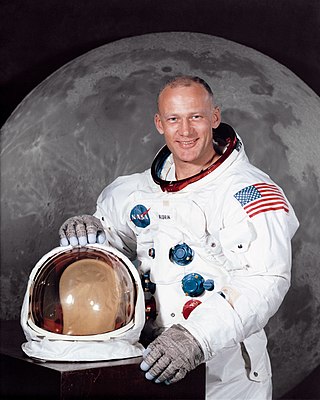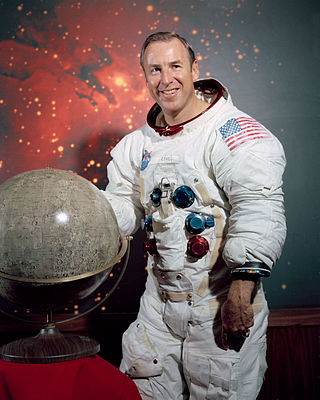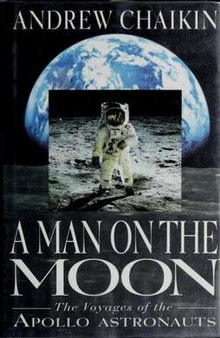
Apollo 11 was a spaceflight conducted by the United States from July 16 to July 24, 1969. It marked the first time that humans landed on the Moon. Commander Neil Armstrong and Lunar Module Pilot Buzz Aldrin landed the Apollo Lunar Module Eagle on July 20, 1969, at 20:17 UTC, and Armstrong became the first person to step onto the Moon's surface six hours and 39 minutes later, on July 21 at 02:56 UTC. Aldrin joined him 19 minutes later, and they spent about two and a quarter hours together exploring the site they had named Tranquility Base upon landing. Armstrong and Aldrin collected 47.5 pounds (21.5 kg) of lunar material to bring back to Earth as pilot Michael Collins flew the Command Module Columbia in lunar orbit, and were on the Moon's surface for 21 hours, 36 minutes, before lifting off to rejoin Columbia.

Apollo 13 was the seventh crewed mission in the Apollo space program and would have been the third Moon landing. The craft was launched from Kennedy Space Center on April 11, 1970, but the landing was aborted after an oxygen tank in the service module (SM) exploded two days into the mission, disabling its electrical and life-support system. The crew, supported by backup systems on the lunar module (LM), instead looped around the Moon in a circumlunar trajectory and returned safely to Earth on April 17. The mission was commanded by Jim Lovell, with Jack Swigert as command module (CM) pilot and Fred Haise as lunar module (LM) pilot. Swigert was a late replacement for Ken Mattingly, who was grounded after exposure to rubella.

Apollo 9 was the third human spaceflight in NASA's Apollo program. Flown in low Earth orbit, it was the second crewed Apollo mission that the United States launched via a Saturn V rocket, and was the first flight of the full Apollo spacecraft: the command and service module (CSM) with the Lunar Module (LM). The mission was flown to qualify the LM for lunar orbit operations in preparation for the first Moon landing by demonstrating its descent and ascent propulsion systems, showing that its crew could fly it independently, then rendezvous and dock with the CSM again, as would be required for the first crewed lunar landing. Other objectives of the flight included firing the LM descent engine to propel the spacecraft stack as a backup mode, and use of the portable life support system backpack outside the LM cabin.

Apollo 10 was the fourth human spaceflight in the United States' Apollo program and the second to orbit the Moon. NASA, the mission's operator, described it as a "dress rehearsal" for the first Moon landing. It was designated an "F" mission, intended to test all spacecraft components and procedures short of actual descent and landing.

Apollo 12 was the sixth crewed flight in the United States Apollo program and the second to land on the Moon. It was launched on November 14, 1969, by NASA from the Kennedy Space Center, Florida. Commander Charles "Pete" Conrad and Lunar Module Pilot Alan L. Bean completed just over one day and seven hours of lunar surface activity while Command Module Pilot Richard F. Gordon remained in lunar orbit.

Apollo 14 was the eighth crewed mission in the United States Apollo program, the third to land on the Moon, and the first to land in the lunar highlands. It was the last of the "H missions", landings at specific sites of scientific interest on the Moon for two-day stays with two lunar extravehicular activities.

Apollo 17 was the eleventh and final mission of NASA's Apollo program, the sixth and most recent time humans have set foot on the Moon or traveled beyond low Earth orbit. Commander Gene Cernan and Lunar Module Pilot Harrison Schmitt walked on the Moon, while Command Module Pilot Ronald Evans orbited above. Schmitt was the only professional geologist to land on the Moon; he was selected in place of Joe Engle, as NASA had been under pressure to send a scientist to the Moon. The mission's heavy emphasis on science meant the inclusion of a number of new experiments, including a biological experiment containing five mice that was carried in the command module.

Neil Alden Armstrong was an American astronaut and aeronautical engineer who, in 1969, became the first person to walk on the Moon. He was also a naval aviator, test pilot, and university professor.

Buzz Aldrin is an American former astronaut, engineer and fighter pilot. He made three spacewalks as pilot of the 1966 Gemini 12 mission, and was the Lunar Module Eagle pilot on the 1969 Apollo 11 mission. He was the second person to walk on the Moon after mission commander Neil Armstrong. Following the death of Michael Collins in 2021, he is the last surviving Apollo 11 crew member.

Alan LaVern Bean was an American naval officer and aviator, aeronautical engineer, test pilot, NASA astronaut and painter. He was selected to become an astronaut by NASA in 1963 as part of Astronaut Group 3, and was the fourth person to walk on the Moon.

David Randolph Scott is an American retired test pilot and NASA astronaut who was the seventh person to walk on the Moon. Selected as part of the third group of astronauts in 1963, Scott flew to space three times and commanded Apollo 15, the fourth lunar landing; he is one of four surviving Moon walkers and the only living commander of a spacecraft that landed on the Moon.

James Arthur Lovell Jr. is an American retired astronaut, naval aviator, test pilot and mechanical engineer. In 1968, as command module pilot of Apollo 8, he became, with Frank Borman and William Anders, one of the first three astronauts to fly to and orbit the Moon. He then commanded the Apollo 13 lunar mission in 1970 which, after a critical failure en route, looped around the Moon and returned safely to Earth.

Clifton Curtis Williams Jr., was an American naval aviator, test pilot, mechanical engineer, major in the United States Marine Corps, and NASA astronaut, who was killed in a plane crash; he never went into space. The crash was caused by a mechanical failure in a NASA T-38 jet trainer, which he was piloting to visit his parents in Mobile, Alabama. The failure caused the flight controls to stop responding, and although he activated the ejection seat, it did not save him. He was the fourth astronaut from NASA's Astronaut Group 3 to have died, the first two having been killed in separate T-38 flights, and the third in the Apollo 1 fire earlier that year. The aircraft crashed in Florida near Tallahassee within an hour of departing Patrick AFB.

From the Earth to the Moon is a twelve-part 1998 HBO television miniseries co-produced by Ron Howard, Brian Grazer, Tom Hanks and Michael Bostick. In docudrama format, it tells the story of the Apollo program during the 1960s and early 1970s. Largely based on Andrew Chaikin's 1994 book, A Man on the Moon, the series is known for its accurate telling of the story of Apollo and the special effects under visual director Ernest D. Farino. The series takes its title from, but is not based upon, Jules Verne's 1865 science fiction novel From the Earth to the Moon.

Alfred Merrill Worden was an American test pilot, engineer and NASA astronaut who was command module pilot for the Apollo 15 lunar mission in 1971. One of 24 people to have flown to the Moon, he orbited it 74 times in the command module (CM) Endeavour.
Andrew L. Chaikin is an American author, speaker and science journalist. He lives in Vermont.

Earthrise is a photograph of Earth and part of the Moon's surface that was taken from lunar orbit by astronaut William Anders on December 24, 1968, during the Apollo 8 mission. Nature photographer Galen Rowell described it as "the most influential environmental photograph ever taken".
Astronauts and other spaceflight participants have observed their religions while in space; sometimes publicly, sometimes privately. Religious adherence in outer space poses unique challenges and opportunities for practitioners. Space travelers have reported profound changes in the way they view their faith related to the overview effect, while some secular groups have criticized the use of government spacecraft for religious activities by astronauts.

The Lunar Flag Assembly (LFA) was a kit containing a flag of the United States designed to be erected on the Moon during the Apollo program. Six such flag assemblies were planted on the Moon. The nylon flags were hung on telescoping staffs and horizontal bars constructed of one-inch anodized aluminum tubes. The flags were carried on the outside of the Apollo Lunar Module (LM), most of them on the descent ladder inside a thermally insulated tubular case to protect them from exhaust gas temperatures calculated to reach 2,000 °F (1,090 °C). The assembly was designed and supervised by Jack Kinzler, head of technical services at the Manned Spacecraft Center (MSC) in Houston, Texas. Six of the flags were ordered from a government supply catalog and measured 3 by 5 feet ; the last one planted on the Moon was the slightly larger, 6-foot (1.8 m)-wide flag which had hung in the MSC Mission Operations Control Room for most of the Apollo program.

















